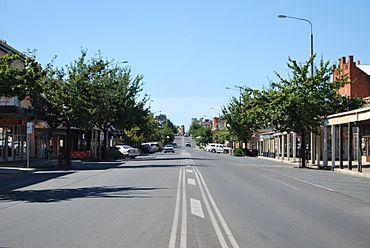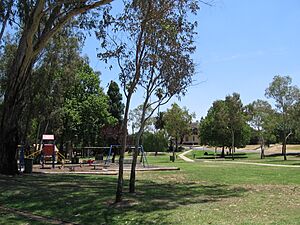Corowa facts for kids
Quick facts for kids CorowaNew South Wales |
|||||||||
|---|---|---|---|---|---|---|---|---|---|

A view of the main street of Corowa
|
|||||||||
| Population | 5,595 (2021 census) | ||||||||
| Established | 1858 | ||||||||
| Postcode(s) | 2646 | ||||||||
| Elevation | 143 m (469 ft) | ||||||||
| Location | |||||||||
| LGA(s) | Federation Council | ||||||||
| County | Hume | ||||||||
| State electorate(s) | Albury | ||||||||
| Federal Division(s) | Farrer | ||||||||
|
|||||||||
Corowa is a town in the state of New South Wales in Australia. It sits right on the Murray River, which forms the border between New South Wales and Victoria. Across the river is the Victorian town of Wahgunyah. Corowa is the biggest town in the Federation Council.
The name "Corowa" might come from an Aboriginal word. It could refer to the curra pine tree, which gave a special gum used by Aboriginal people. This gum helped them attach spearheads to shafts. Another idea is that the name means "rocky river."
Corowa has two bridges that cross the Murray River to Wahgunyah. One is the historic John Foord Bridge. The other is the Federation Bridge, which opened in 2005. The town is also known for its sports teams. Corowa and nearby Rutherglen share an Australian Rules football team, the Corowa-Rutherglen. They play in the Ovens & Murray Football League. Corowa also has a rugby league team, the Corowa Cougars, who play in the Goulburn Murray competition.
Contents
Corowa's History
Early Beginnings
The Bangerang People
The original Aboriginal people of the Corowa area are called the Bangerang people. They lived on this land for thousands of years. Their language had different spellings, but they were the first inhabitants of this region.
John Foord and the Punt
A man named John Foord, sometimes called "The Emperor of Wahgunyah," settled near the Murray River in the 1840s. He bought a special boat called a "punt" around 1855. This punt helped people and goods cross the river. It was very important for trade and travel.
Because of Foord's punt, more people came to the area. This led to the start of Corowa township, right across from Wahgunyah. In 1892, a railway line opened, connecting Corowa to Culcairn. It closed in 1989.
Growing as a Town

In 1857, the land for Corowa was measured. The next year, in 1858, the town was officially declared. People wanted a bridge to replace the punt. So, in 1861, they started building a bridge between Wahgunyah and Corowa. It cost about £8,000 and was likely paid for by private groups.
The Corowa Post Office opened in 1861. An Anglican church was built in 1861 on land given by John Foord. By 1868, Corowa was becoming a very important border town. New buildings like a store, hotels, and a court-house were built.
A branch of the Bank of New South Wales opened in 1874. A Roman Catholic church also started being built that year. By 1875, Corowa was growing fast and had seven hotels!
In 1879, a newspaper reported that Corowa had one main street with all the businesses. Richer residents lived on a nearby hill. The original government-planned town, which was two miles from the river, didn't grow much. This was because it was hard to get to the bridge from there. Also, crossing the bridge cost a lot of money, which made it harder for people to travel between Corowa and Wahgunyah.
Later Developments
In 1882, the New South Wales Government bought the bridge between Corowa and Wahgunyah. A Presbyterian church and a meeting hall for the Oddfellows' group were built in Corowa in 1886.
The Federation Movement
In the 1890s, Corowa became a very important place for Australia's history. Several big meetings were held here. These meetings helped lead to the federation of the different colonies into one country, the Commonwealth of Australia, in 1901. This was a huge step in creating the Australia we know today.
Gold Mining Attempts
Just north of Corowa, there was a large gold mine called the Corowa Deep Lead Mine. People thought there might be gold here because there were many gold mines across the border in Rutherglen.
In 1893, a company started looking for gold by drilling holes deep into the ground. They found gold-bearing gravel about 307 feet down in late 1894. A new company was formed, and mining began in 1897. The government even helped pay for some of the work.
Miners dug two shafts. It was very hard because of a lot of underground water. They had to pump out huge amounts of water, sometimes over 750,000 gallons a day! They also had to dig through very hard rock to reach the gold.
By 1902, they found small amounts of gold. But the company needed more money to keep going. Even though a newspaper said the mine was successful, the company ran out of money. The mine closed in 1905. It had sold some gold, but the costs were too high to make a profit.
Important Places
Heritage Sites
Corowa has several places that are important for their history. These are called heritage-listed sites:
- 8 Church Street: The Corowa Courthouse
- Culcairn-Corowa railway: The old Corowa railway station
- Steel Street: The Corowa Flour Mill
Town Facts
Population Changes
| Historical population | ||
|---|---|---|
| Year | Pop. | ±% |
| 1921 | 2,387 | — |
| 1933 | 2,757 | +15.5% |
| 1947 | 2,751 | −0.2% |
| 1954 | 3,045 | +10.7% |
| 1961 | 2,593 | −14.8% |
| 1966 | 2,709 | +4.5% |
| 1971 | 2,923 | +7.9% |
| 1976 | 3,031 | +3.7% |
| 1981 | 3,390 | +11.8% |
| 1986 | 4,315 | +27.3% |
| 1991 | 5,064 | +17.4% |
| 1996 | 5,785 | +14.2% |
| 2001 | 5,208 | −10.0% |
| 2006 | 5,628 | +8.1% |
| 2011 | 5,450 | −3.2% |
| 2016 | 5,337 | −2.1% |
| 2021 | 5,444 | +2.0% |
| Source: Australian Bureau of Statistics data. | ||
Corowa's Climate
Corowa has a temperate humid subtropical climate. This means it has hot, mostly dry summers. The winters are cool and wetter.
| Climate data for Corowa Airport (1907–2022, rainfall to 1890); 143 metres or 469 feet AMSL; 35.99° S, 146.36° E | |||||||||||||
|---|---|---|---|---|---|---|---|---|---|---|---|---|---|
| Month | Jan | Feb | Mar | Apr | May | Jun | Jul | Aug | Sep | Oct | Nov | Dec | Year |
| Record high °C (°F) | 46.0 (114.8) |
46.0 (114.8) |
40.5 (104.9) |
34.0 (93.2) |
28.4 (83.1) |
23.0 (73.4) |
20.0 (68.0) |
26.3 (79.3) |
33.5 (92.3) |
36.0 (96.8) |
42.5 (108.5) |
42.5 (108.5) |
46.0 (114.8) |
| Mean daily maximum °C (°F) | 31.9 (89.4) |
31.3 (88.3) |
27.9 (82.2) |
22.5 (72.5) |
17.8 (64.0) |
13.9 (57.0) |
13.1 (55.6) |
15.0 (59.0) |
18.5 (65.3) |
22.2 (72.0) |
26.6 (79.9) |
30.1 (86.2) |
22.6 (72.7) |
| Mean daily minimum °C (°F) | 15.7 (60.3) |
15.7 (60.3) |
12.7 (54.9) |
8.6 (47.5) |
5.6 (42.1) |
3.6 (38.5) |
2.8 (37.0) |
3.7 (38.7) |
5.7 (42.3) |
8.1 (46.6) |
11.1 (52.0) |
13.6 (56.5) |
8.9 (48.0) |
| Record low °C (°F) | 5.0 (41.0) |
6.0 (42.8) |
3.9 (39.0) |
0.0 (32.0) |
−4.5 (23.9) |
−5.0 (23.0) |
−4.5 (23.9) |
−5.0 (23.0) |
−2.0 (28.4) |
0.0 (32.0) |
0.4 (32.7) |
3.7 (38.7) |
−5.0 (23.0) |
| Average precipitation mm (inches) | 36.4 (1.43) |
37.4 (1.47) |
38.0 (1.50) |
36.3 (1.43) |
46.6 (1.83) |
56.0 (2.20) |
54.9 (2.16) |
53.3 (2.10) |
48.2 (1.90) |
51.8 (2.04) |
41.7 (1.64) |
40.9 (1.61) |
541.2 (21.31) |
| Average precipitation days | 4.3 | 3.9 | 4.6 | 5.7 | 8.0 | 10.3 | 11.6 | 11.4 | 9.0 | 8.3 | 6.2 | 5.3 | 88.6 |
| Average afternoon relative humidity (%) | 32 | 33 | 36 | 44 | 56 | 67 | 68 | 60 | 55 | 46 | 38 | 33 | 47 |
Famous People from Corowa
Many well-known people have connections to Corowa:
- Taylor Duryea - An Australian rules footballer.
- Ryan Garthwaite - An Australian rules footballer.
- Sam Groth – An Australian tennis player.
- Charles Raymond Gurney – An Australian aviator and World War 2 pilot, born in Corowa.
- John Howard – An actor born in Corowa.
- Nigel Lappin – An Australian rules football player born in Corowa.
- John Longmire – A retired Australian rules football player who played for North Melbourne Football Club. He has been the coach of Sydney Swans since 2011.
- Ben Mathews – An Australian rules football player for Sydney Swans.
- Stephen Mowlam – An Australian field hockey player who grew up in Corowa.
- Joey Palmer – A cricketer from the 1880s born in Corowa.
- Cathy Svarc – An AFLW player.
- Ruby Svarc – An AFLW player.
- Blake Pavey – A comedian born in Corowa.
- Mike Walsh – A television host.
Images for kids



